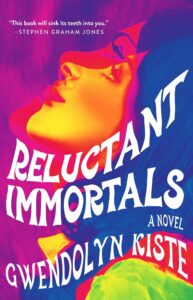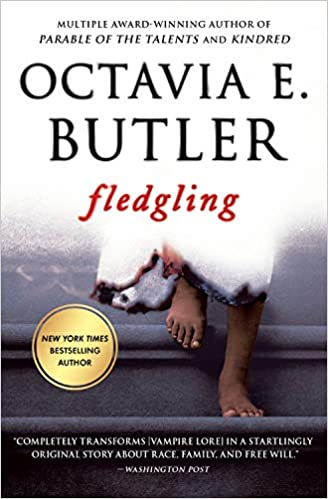This is a fascinating story about the trauma inflicted on women by violent men. It’s told from the point of view of women in classic novels who were tossed to the side by literary history: Lucy from Dracula and Bertha, a.k.a. the Mad Woman in the Attic, from Jane Eyre.
Lucy and Bee enjoy their daily ritual. They spend their evenings at the local drive-in theater and then go home to clean up the decay. Meanwhile, Dracula’s ashes that Lucy keeps in various urns haunt and taunt her, trying to get her to become a monster like him. This is less a retelling and more a rewriting of classic characters.
Rochester and Dracula torture their victims, Lucy and Bee, by calling out from afar. These supernatural, ghostly hauntings act as a symbol of how it feels in reality for victims of trauma. While Lucy is a vampire, Bee is immortal for other reasons caused by Rochester. The story unfolds to show how trauma, no matter how much time passes and in whatever form it comes, lives on.
Kiste offers an interesting twist on vampire lore. Sunlight doesn’t kill them, but it does weaken them into a state of hallucination where they relive their pasts. Vampires also live in homes in a state of decay because it is caused by their own, like power within that seeps into everything they touch; they are death itself.
Like the vampire lore of Dracula, Lucy has the power to mesmerize people and put them under her control. She often does it by accident and feels shame when it occurs. She lives her life without ever feeding on humans, never taking what Dracula always tells her is hers. She constantly fights her monstrous nature, showing how trauma can turn victims into perpetrators of further pain and hurt.
When Jane appears, she is not portrayed as the heroine of her novel, but rather as a victim of Rochester’s manipulation. Although she loves Bee, Rochester still holds power over her. After decades of keeping a low profile and keeping their torturers at bay, the time comes for Lucy and Bee to face Rochester and Dracula.
For so many years, Lucy and Bee lived as companions, but they refused to talk about the horrors they went through. They never really knew each other, and the return of their tormentors forces them to be honest with each other and with themselves. It’s only once this happens they can fight Rochester and Dracula, finally facing their ghosts.
Along the way, the two villains create more victims that Lucy and Bee could not save. The men expect these women to act in their favor and do their dirty work, but the moment Lucy acknowledges their trauma, they become sisters in arms. These men constantly claim to love Lucy, Bee and all the other women they’ve used. They use love to keep excusing their behavior and manipulating their victims.
Throughout the story, Rochester and Dracula’s legacy in pop culture continues to keep Lucy and Bee out of their own narrative. But in the end, the women use that narrative to create a power of their own to defeat their enemies. Lucy and Bee regain control of their narrative and prove that although they each came from a monster, they don’t have to become one.
Perhaps the most salient flaw was the pacing. It moves so slowly that by the time you get to the action, it takes a moment to kick in and realize, “Oh yes we’ve reached the climax of this build-up.” But even so, it’s still an enthralling story. And I quite enjoyed its quiet ending.

